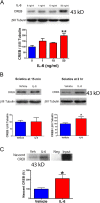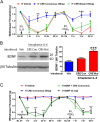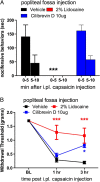Local translation and retrograde axonal transport of CREB regulates IL-6-induced nociceptive plasticity
- PMID: 24993495
- PMCID: PMC4091745
- DOI: 10.1186/1744-8069-10-45
Local translation and retrograde axonal transport of CREB regulates IL-6-induced nociceptive plasticity
Abstract
Transcriptional regulation of genes by cyclic AMP response element binding protein (CREB) is essential for the maintenance of long-term memory. Moreover, retrograde axonal trafficking of CREB in response to nerve growth factor (NGF) is critical for the survival of developing primary sensory neurons. We have previously demonstrated that hindpaw injection of interleukin-6 (IL-6) induces mechanical hypersensitivity and hyperalgesic priming that is prevented by the local injection of protein synthesis inhibitors. However, proteins that are locally synthesized that might lead to this effect have not been identified. We hypothesized that retrograde axonal trafficking of nascently synthesized CREB might link local, activity-dependent translation to nociceptive plasticity. To test this hypothesis, we determined if IL-6 enhances the expression of CREB and if it subsequently undergoes retrograde axonal transport. IL-6 treatment of sensory neurons in vitro caused an increase in CREB protein and in vivo treatment evoked an increase in CREB in the sciatic nerve consistent with retrograde transport. Importantly, co-injection of IL-6 with the methionine analogue azido-homoalanine (AHA), to assess nascently synthesized proteins, revealed an increase in CREB containing AHA in the sciatic nerve 2 hrs post injection, indicating retrograde transport of nascently synthesized CREB. Behaviorally, blockade of retrograde transport by disruption of microtubules or inhibition of dynein or intrathecal injection of cAMP response element (CRE) consensus sequence DNA oligonucleotides, which act as decoys for CREB DNA binding, prevented the development of IL-6-induced mechanical hypersensitivity and hyperalgesic priming. Consistent with previous studies in inflammatory models, intraplantar IL-6 enhanced the expression of BDNF in dorsal root ganglion (DRG). This effect was blocked by inhibition of retrograde axonal transport and by intrathecal CRE oligonucleotides. Collectively, these findings point to a novel mechanism of axonal translation and retrograde trafficking linking locally-generated signals to long-term nociceptive sensitization.
Figures




Similar articles
-
Peripheral prostaglandin E2 prolongs the sensitization of nociceptive dorsal root ganglion neurons possibly by facilitating the synthesis and anterograde axonal trafficking of EP4 receptors.Exp Neurol. 2014 Nov;261:354-66. doi: 10.1016/j.expneurol.2014.05.028. Epub 2014 Jun 5. Exp Neurol. 2014. PMID: 24910202
-
Colitis elicits differential changes in the expression levels of receptor tyrosine kinase TrkA and TrkB in colonic afferent neurons: a possible involvement of axonal transport.Pain. 2010 Oct;151(1):117-127. doi: 10.1016/j.pain.2010.06.029. Epub 2010 Jul 16. Pain. 2010. PMID: 20638179 Free PMC article.
-
Prostaglandin E2 contributes to the synthesis of brain-derived neurotrophic factor in primary sensory neuron in ganglion explant cultures and in a neuropathic pain model.Exp Neurol. 2012 Apr;234(2):466-81. doi: 10.1016/j.expneurol.2012.01.021. Epub 2012 Jan 27. Exp Neurol. 2012. PMID: 22309829
-
Cellular, molecular, and epigenetic mechanisms in non-associative conditioning: implications for pain and memory.Neurobiol Learn Mem. 2013 Oct;105:133-50. doi: 10.1016/j.nlm.2013.06.008. Epub 2013 Jun 22. Neurobiol Learn Mem. 2013. PMID: 23796633 Free PMC article. Review.
-
Axonal Transport and Neurodegeneration: How Marine Drugs Can Be Used for the Development of Therapeutics.Mar Drugs. 2016 May 19;14(5):102. doi: 10.3390/md14050102. Mar Drugs. 2016. PMID: 27213408 Free PMC article. Review.
Cited by
-
Exploring the role of spinal astrocytes in the onset of hyperalgesic priming signals in acid-induced chronic muscle pain.PNAS Nexus. 2024 Aug 30;3(9):pgae362. doi: 10.1093/pnasnexus/pgae362. eCollection 2024 Sep. PNAS Nexus. 2024. PMID: 39228816 Free PMC article.
-
Electrical stimulation enhances mitochondrial trafficking as a neuroprotective mechanism against chemotherapy-induced peripheral neuropathy.iScience. 2024 Jan 30;27(3):109052. doi: 10.1016/j.isci.2024.109052. eCollection 2024 Mar 15. iScience. 2024. PMID: 38375222 Free PMC article.
-
Differential Activation of pERK1/2 and c-Fos Following Injury to Different Regions of Primary Sensory Neuron.Life (Basel). 2022 May 19;12(5):752. doi: 10.3390/life12050752. Life (Basel). 2022. PMID: 35629419 Free PMC article.
-
Sensory TRP channels: the key transducers of nociception and pain.Prog Mol Biol Transl Sci. 2015;131:73-118. doi: 10.1016/bs.pmbts.2015.01.002. Epub 2015 Feb 12. Prog Mol Biol Transl Sci. 2015. PMID: 25744671 Free PMC article. Review.
-
Valproate attenuates somatic hyperalgesia induced by orofacial inflammation combined with stress through inhibiting spinal IL-6 and STAT1 phosphorylation.Brain Res Bull. 2024 Mar;208:110889. doi: 10.1016/j.brainresbull.2024.110889. Epub 2024 Jan 28. Brain Res Bull. 2024. PMID: 38290590 Free PMC article.
References
-
- Woolf CJ, Walters ET. Common patterns of plasticity contributing to nociceptive sensitization in mammals and Aplysia. Trends Neurosci. 1991;14(2):74–78. - PubMed
Publication types
MeSH terms
Substances
Grants and funding
LinkOut - more resources
Full Text Sources
Other Literature Sources

